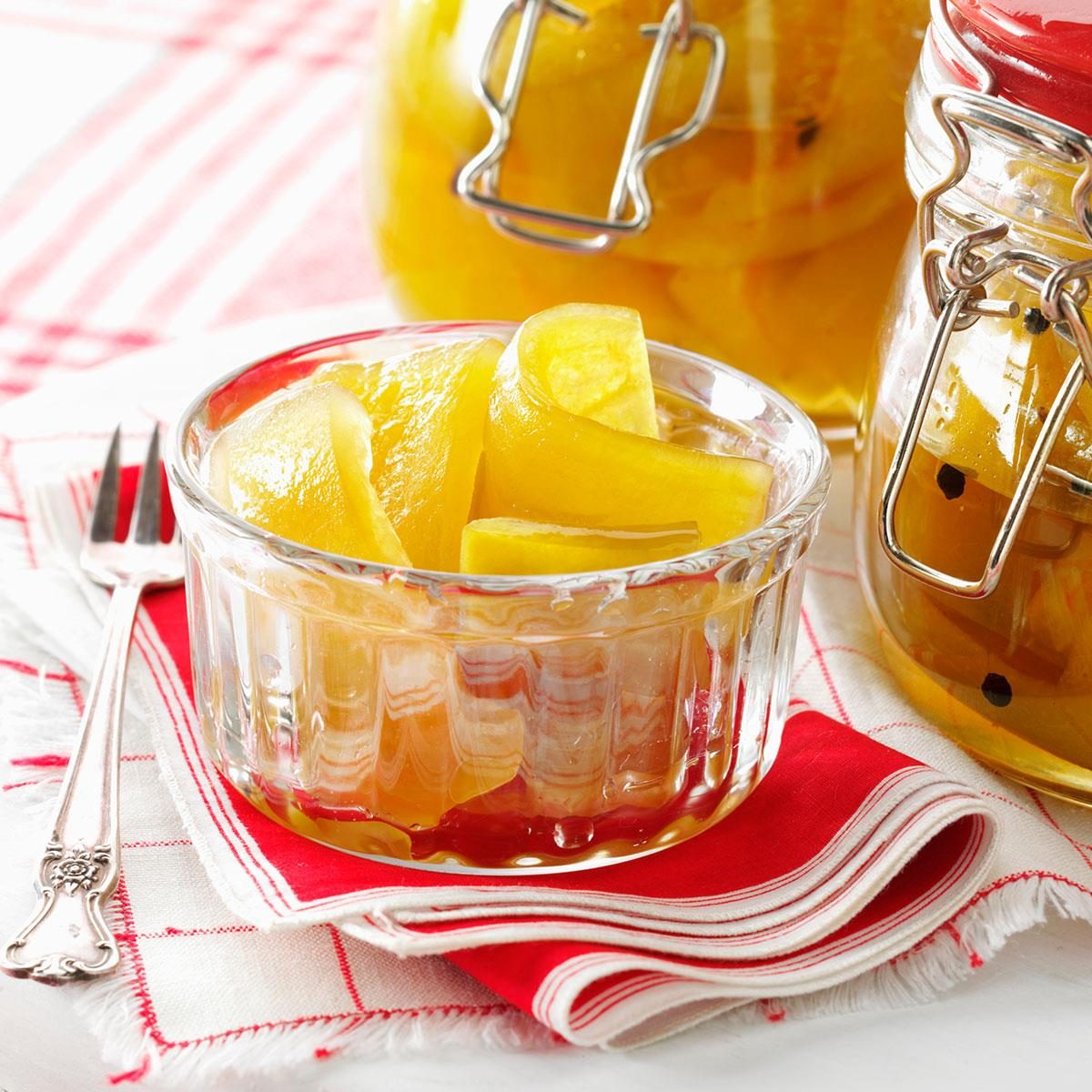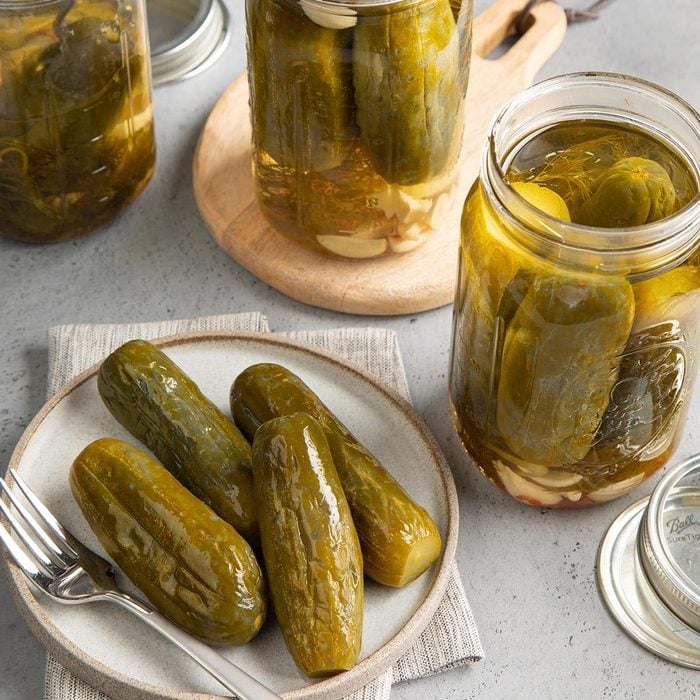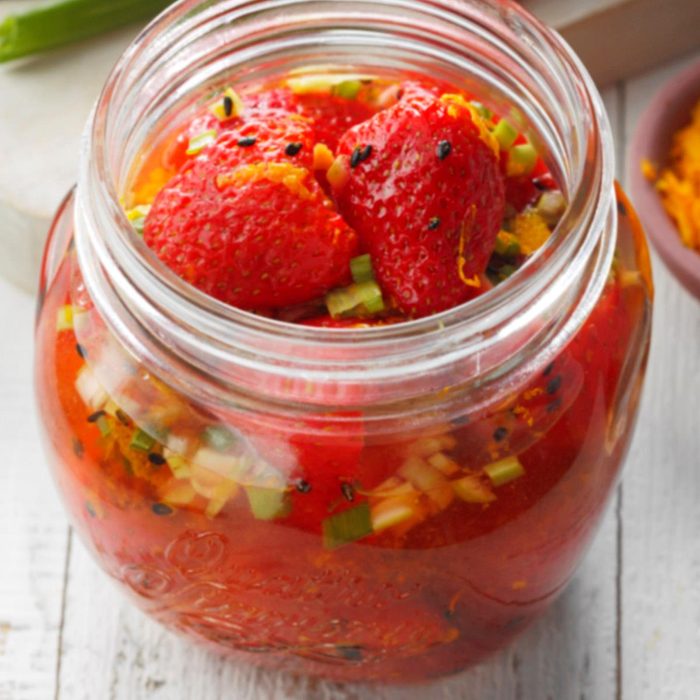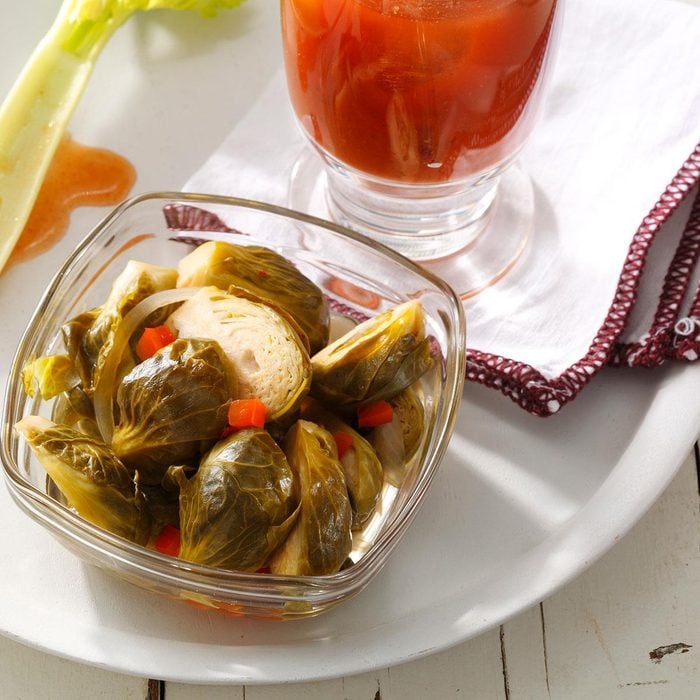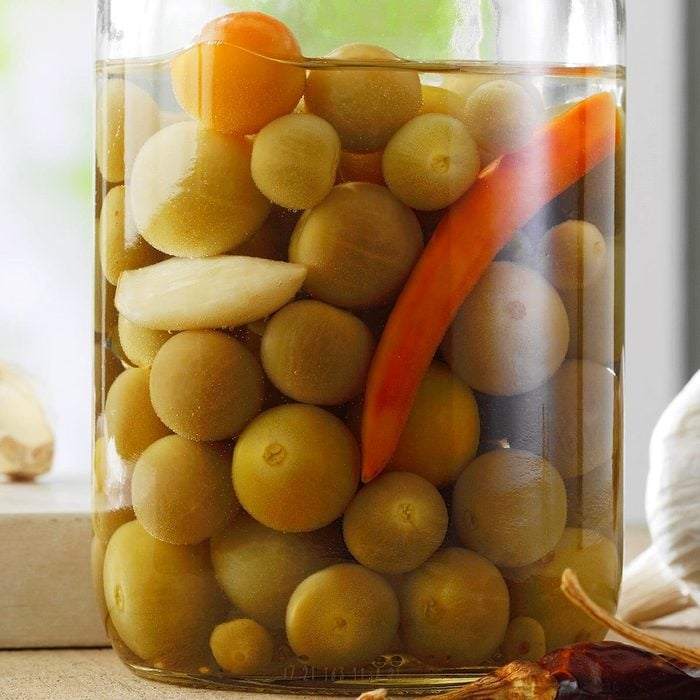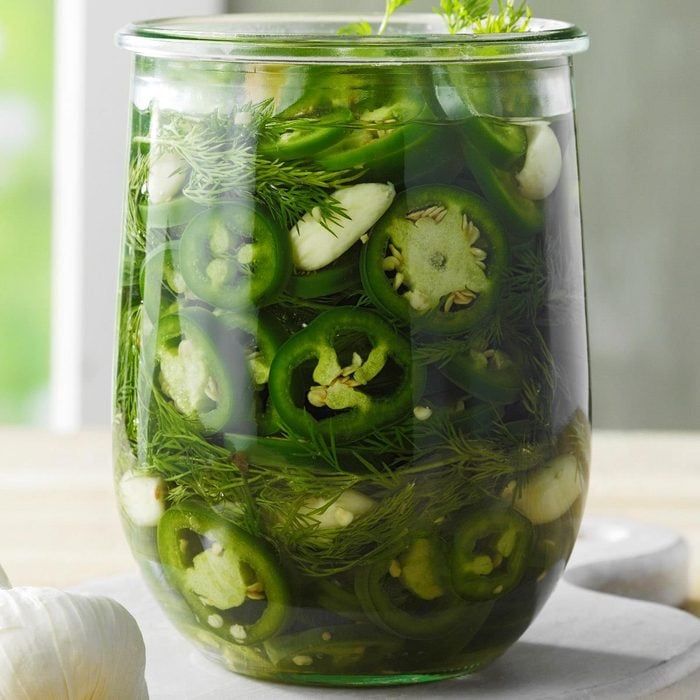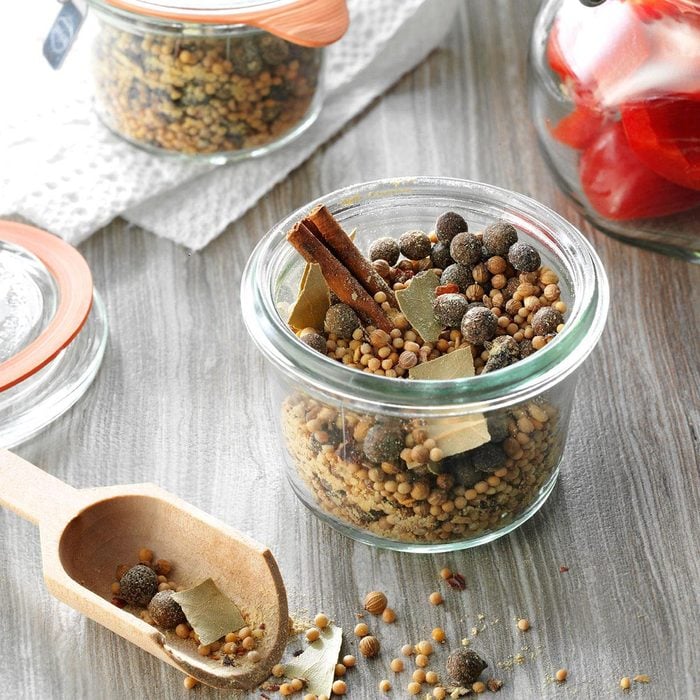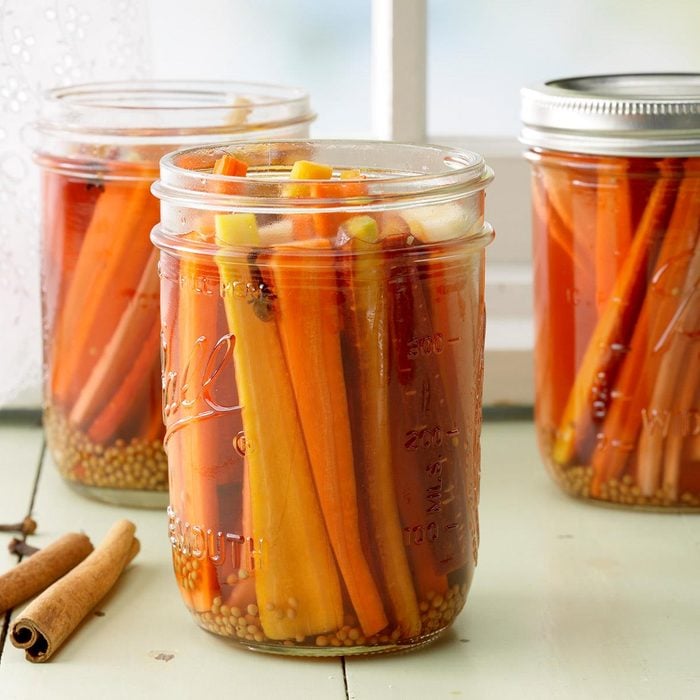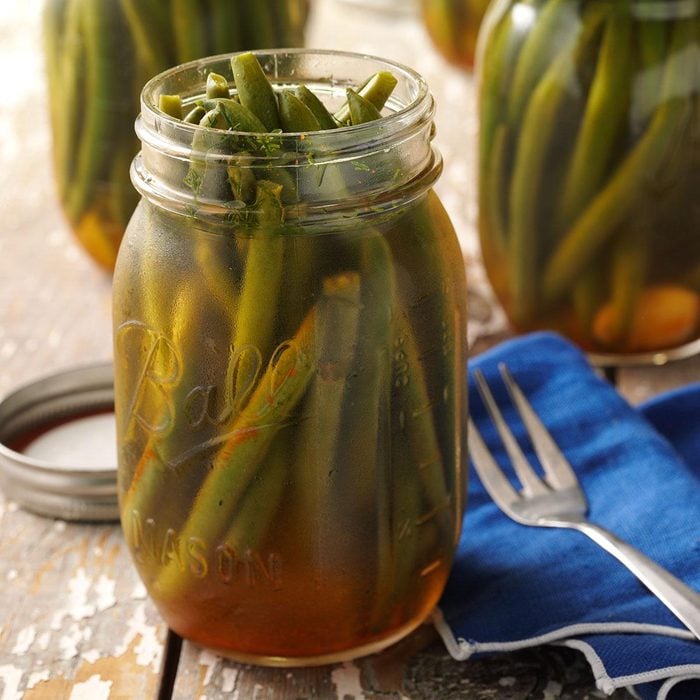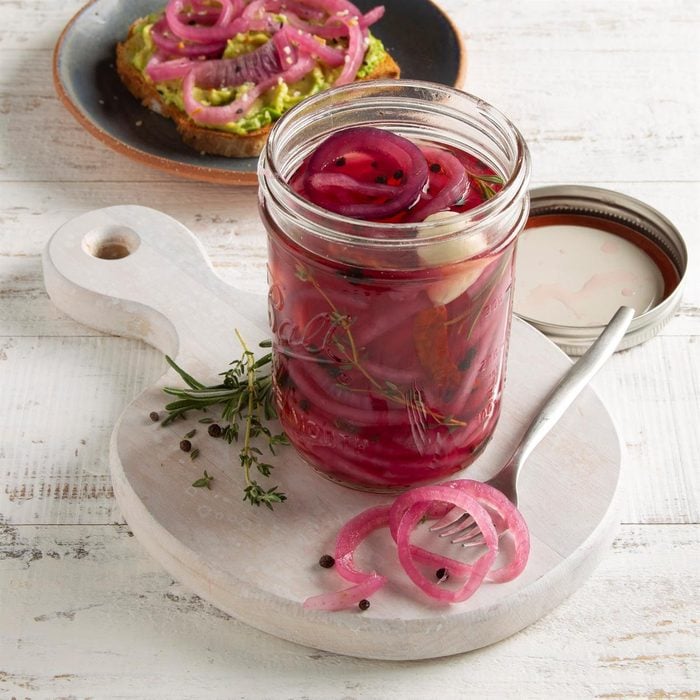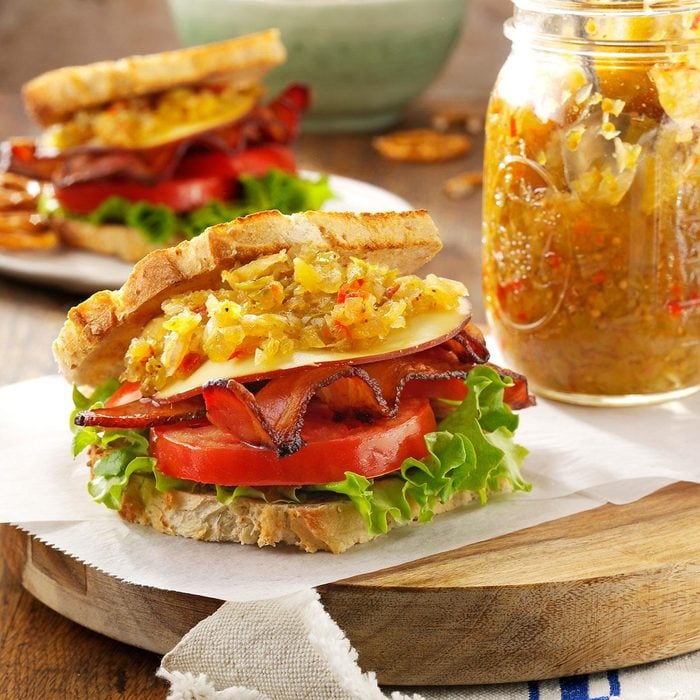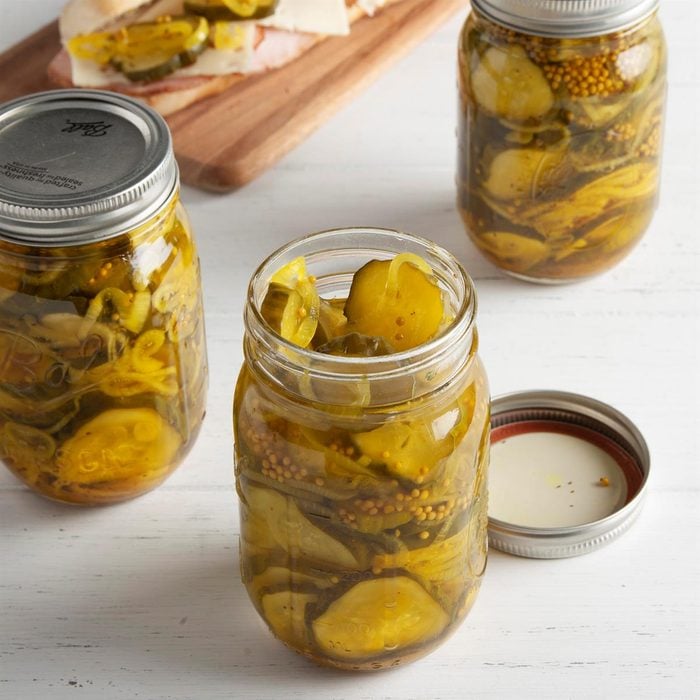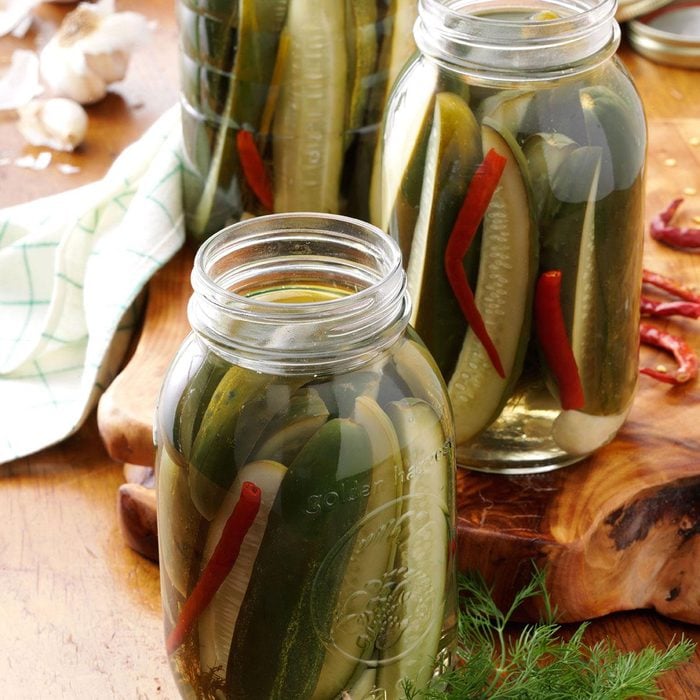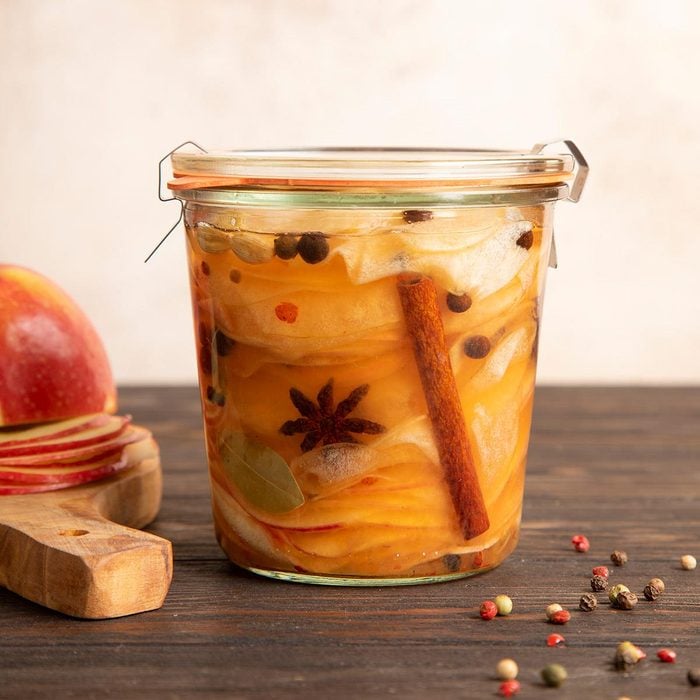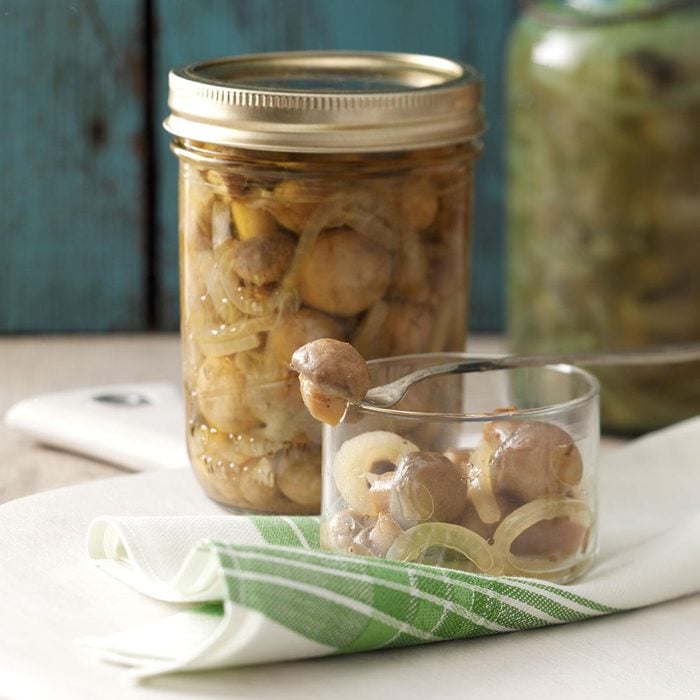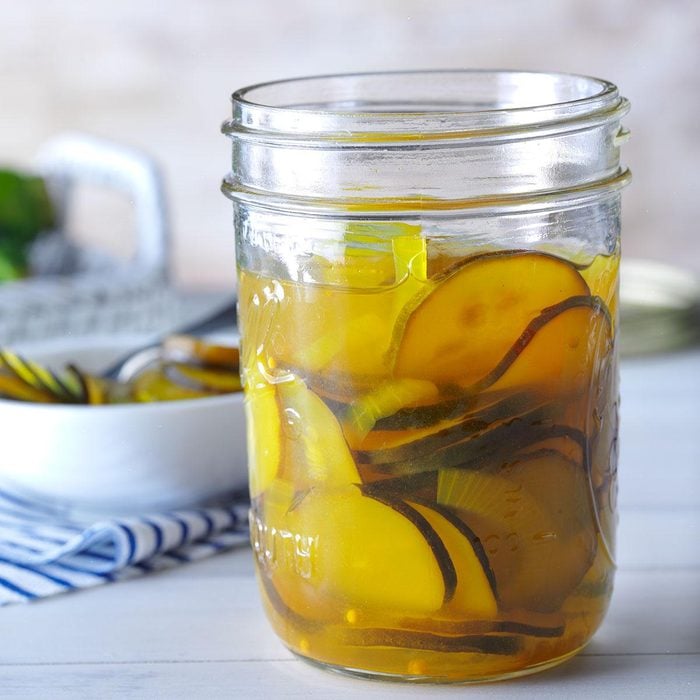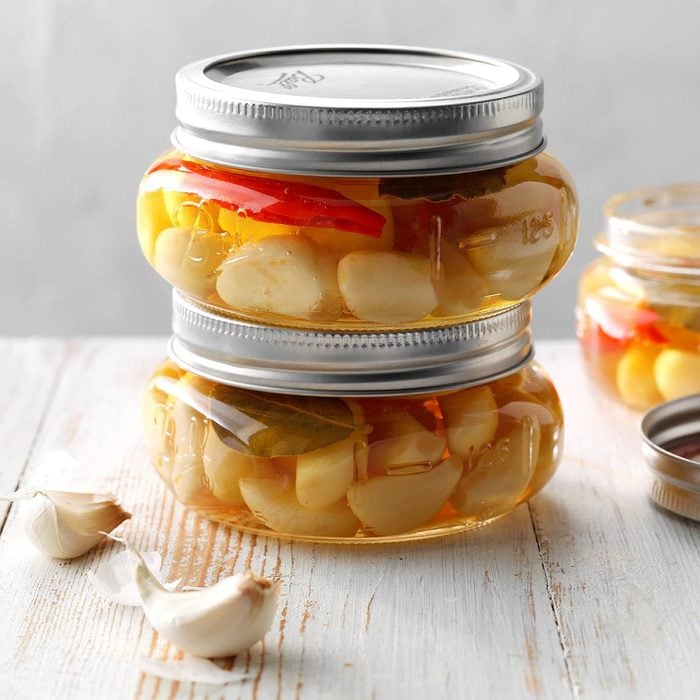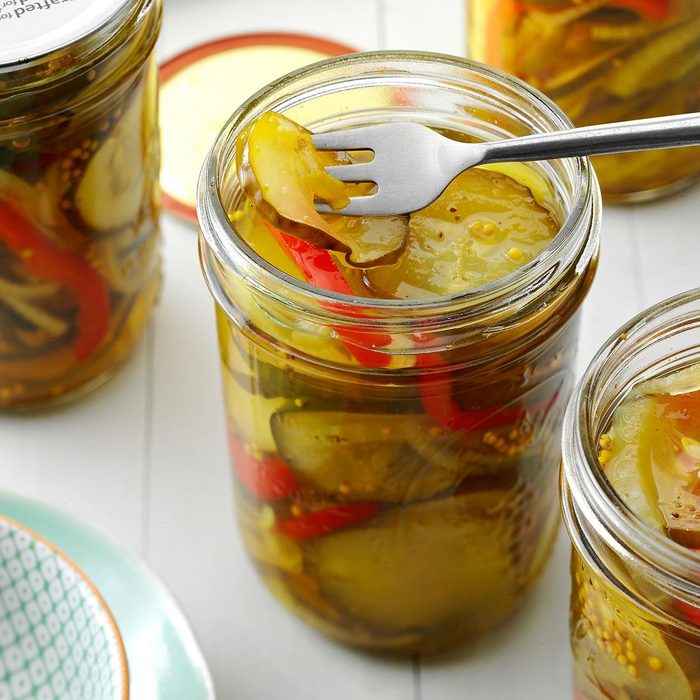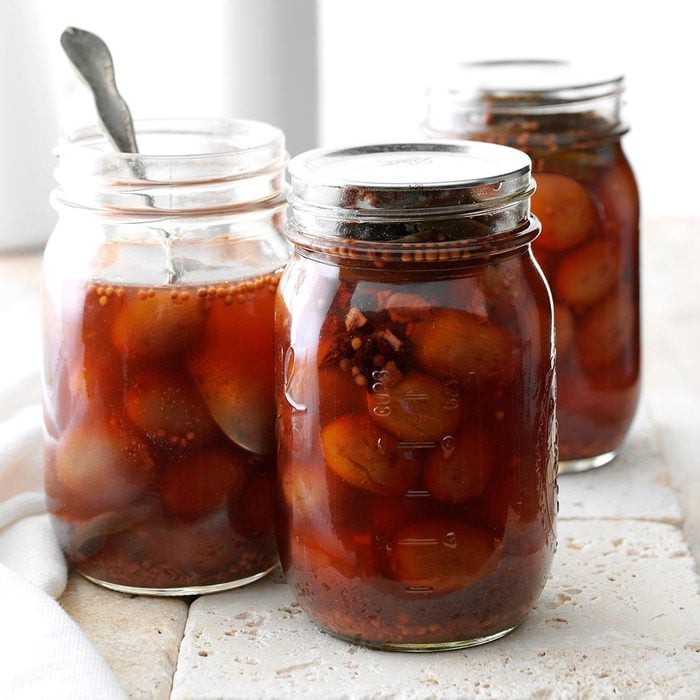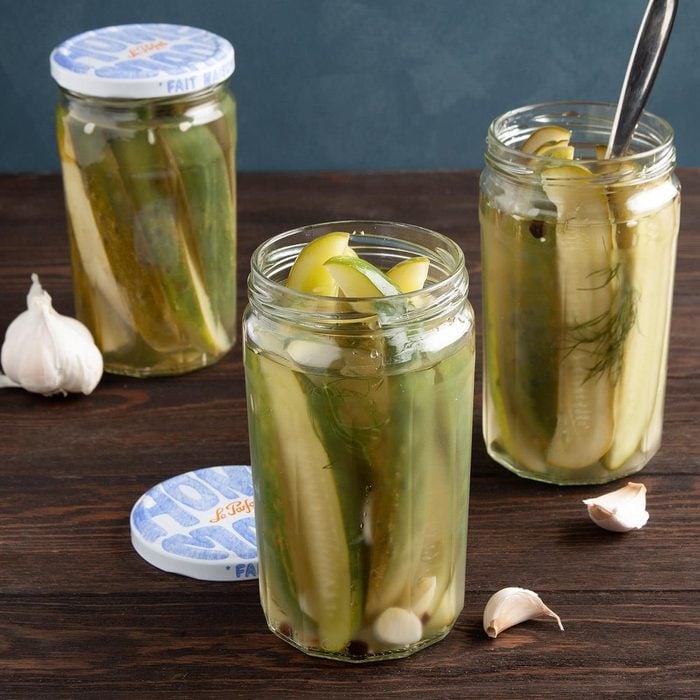ⓘ
Crunch, tang, garden freshness—that’s what you get when you know how to can pickles. (Already popped open a can? Try these recipes for pickle lovers.) Whether you’re canny at canning or consider yourself a beginner, we’ve rounded up our best tips for making delicious pickles you’ll be sneaking downstairs to snack on. Read through this guide, then get canning!
Also, check what is a pickle all about!
Things to Know Before You Start Pickling
So, how are pickles made? Before you get started, there are a few important basics to learn. Follow them for the best results—and be sure not to make any of these common pickling mistakes.
1. Choose the right vinegar
When it comes to pickling recipes, use white vinegar for a little more sharpness. If you’re going for a milder flavor, use cider vinegar. For extra-crunchy pickles, grab 10%-strength vinegar.
2. Know your cucumber
What kind of cucumbers are the best for making pickles? Cukes labeled as canning or pickling cucumbers are a shoo-in, but you can use traditional ones, too. It’s best to choose a cucumber with a thicker skin.
You can use organic or regular cucumbers, but the key is to buy cucumbers without the shiny wax coating that supermarkets use. The wax is edible, but it’ll change the texture of your pickles.
3. Don’t use table salt
While it might be tempting to use table salt because you already have it at home, make sure you secure canning salt before you get started. What’s the difference between canning salt and table salt? Canning salt is extra fine and doesn’t contain caking agents or additives like iodine. If you don’t have canning salt on hand (also called pickling salt), kosher salt works, too. Here’s more on the different types of salt.
4. Sterilize your jar
Here’s how to sterilize: Wash the jars and caps in hot, soapy water and rinse thoroughly. Dry the bands on a towel. Put the jars in a large kettle with enough water to cover them by at least 2 inches, then boil for 10 minutes to sterilize. Turn off the heat, but leave the jars in the water until they’re ready to be filled.
For the lids, place them in a separate small saucepan and cover them with water. Bring the water to 180°F and simmer for 10 minutes. Remove the lids from the heat until you’re ready to start canning.
How to Can Pickles
Gather the following canning supplies and get started learning how to can pickles! We’re using this recipe for the best ever sweet pickles.
Tools you’ll need
Ingredients
- 9 cups sliced pickling cucumbers
- 1 large sweet onion, halved and thinly sliced
- 1/4 cup canning salt
- 1 cup sugar
- 1 cup water
- 1 cup white vinegar
- 1/2 cup cider vinegar
- 2 tablespoons mustard seed
- 1 teaspoon celery seed
- 1/2 teaspoon whole peppercorns
- 4 bay leaves
- 12 garlic cloves, crushed
- Crushed ice
Directions
Step 1: Soak the cucumbers
 TMB Studio
TMB Studio
In a large, nonreactive bowl, combine the cucumbers, onion and salt. Cover with crushed ice and mix well. Let stand 3 hours. Drain; rinse and drain thoroughly.
Step 2: Make the vinegar mixture and add the cucumbers
 TMB Studio
TMB Studio
In a Dutch oven, combine sugar, water, vinegars, mustard seed, celery seed and peppercorns. Bring to a boil, stirring to dissolve the sugar. Add the cucumber mixture; return to a boil, stirring occasionally. Reduce heat and simmer, uncovered, 4-5 minutes or until heated through.
Step 3: Fill the jars

Carefully ladle the hot mixture into four hot wide-mouth 1-pint jars, leaving 1/2-inch headspace. Add 3 garlic cloves and 1 bay leaf to each jar. Remove air bubbles and, if necessary, adjust the headspace by adding hot pickling liquid. Wipe rims. Center the lids on the jars and screw on the bands until they’re fingertip tight.
Editor’s Tip: Canning lids are designed for one-time use, so don’t use lids that you’ve used to can previously.
Step 3: Can, can, can!
 TMB Studio
TMB Studio
Place the jars into a steam canner with simmering water. Bring to a boil; process for 10 minutes. Remove jars and cool.
Tips for Canning Pickles
 TMB Studio
TMB Studio
How can you tell if the canning seal has formed properly?
You can tell that your jar of pickles was properly sealed by checking for a couple indicators. First, check the lid: It should have a slight concave shape because of the vacuum that was created during canning. If there’s no slight concave shape, it’s not sealed.
Second, if you press down in the center of the lid and it doesn’t give, it’s sealed properly. If you press down and it pops or springs up, the jar of pickles isn’t sealed. You can always process your jar of soon-to-be pickles again if the can didn’t seal properly—so don’t sweat it if it didn’t work the first time.
How long will pickles last?
Before you break the seal and dig into the pickles, you can keep the jar of unopened canned pickles for up to a year. Once you open the jar of pickles, keep them in the fridge for up to a month.
How can you tell if pickles have gone bad?
While canning drastically extends the lifetime of pickles, they still won’t last forever. Better to play it safe rather than sorry by checking for the following signs that they’re no longer edible:
- Before cracking open a jar, look for a bulging lid, a change in color in the pickles, or a change in opacity of the brine. If the brine was clear before and it’s cloudy now, toss the pickles.
- Once you open it, look out for a white film or foam at the top of the jar, any mold growth or any unexpected smells.
Can you use jars in different sizes to can pickles?
The processing time depends on the size of the jar. Most recipes call for either 10 or 15 minutes. The bigger the jar, the longer the processing time. If you want to follow this recipe exactly, use 1-pint jars. If you want bigger or smaller portions, and you’re a first time canner, pick another pickling recipe with the exact size you’re looking to make.
Is it possible to can pickles without a canner?
If you don’t have a canner or a steam canner, you can still can pickles! You’ll need a deep stock pot, big enough for the jars and an extra 4 inches of space above them for boiling water. The cans have to be completely submerged.
You’ll also need to use a metal or silicone rack to separate the jars from the stock pot, because placing them right on the bottom may cause them to crack or break. Get to know if pickles need to be refrigerated.
If you want to avoid canning altogether, you can always make refrigerator pickles or freezer pickles.
Now that you’ve learned how pickles are made, try more of our best pickled recipes, from dill pickle canning recipes to all our other favorite types of pickles.
Watermelon Rind Pickles
"Waste not, want not" has always been smart advice—especially when it produces pickled watermelon rind that's so refreshing. There are many
types of pickles and this for sure is one of a kind! Serve these straight out of the jar at your next backyard barbecue, and be prepared for all your guests to ask for this pickling recipe.
Go to Recipe
If you were wondering, you can also find out if pickles are good for you.
Garlic Dill Pickle RecipeIs there a
type of pickle more iconic than garlic and dill? This recipe makes three 1-quart jars: eat one with these
homemade pastrami sandwiches, another with
Gouda turkey clubs and one all by itself with your bare hands. There's a reason this is one of our favorite pickling recipes!
Also check: What’s sweet, sour, spicy, and red all over? A
chamoy pickle, the latest viral recipe taking over TikTok.
Pickled StrawberriesI developed a unique healthy recipe to feature my most-loved spring and summer fruit. My favorite way to serve these pickled strawberries is as an appetizer with cheese. —Roxanne Chan, Albany, California
Refrigerator Dill PicklesEasy and economical, refrigerator dill pickles are tangy, zesty and crispy. No one will believe you made them yourself! —Jake Haen, Ocala, Florida
Pickled CornWhen fresh corn is in season and you're overeating it straight off the cob, try making pickled corn instead! —Amanda Phillips, Portland, Oregon
Pickled Brussels SproutsBrussels sprouts are delicious and versatile—they're good when
roasted,
grilled and even
raw. It should be no surprise that these sprouts are also outstanding when pickled with garlic, onion and a pinch of chili flakes.
Pickled EggsEver since I can remember, my mother served this pickled egg recipe at Easter. It was a tradition that my family expected. I made them for my granddaughter the last time she visited and they were all gone before she left. —Mary Banker, Fort Worth, Texas
Pickled Green TomatoesI had no clue what to do with all the green tomatoes from my garden until my husband said to pickle them. I thought he was nuts, but they are fantastic! Making pickled green tomatoes is a wonderful way to keep your garden produce from going to waste. —Lori Eaton, Downs, Kansas
Pickled JalapenosI started canning Hungarian hot and mild peppers with my dad every year, but they are hard to find in California, so I now make pickled jalapenos instead. They stay crunchy, unlike the mushy kind you find at the store. —Lou Kostura, Belmont, California
Homemade Pickling SpiceIn the mood for pickling recipes, but don't have store-bought pickling spice on hand? There's a good chance that you already have the ingredients to make this homemade version. Then, get ready to make all kinds of
pickled vegetables.
Pickled CarrotsMy mother is the only other person I've known to make this recipe. In fact, when I take it to a potluck or picnic, no one has ever heard of pickled carrots. But once they try them, they are hooked. —Robin Koble, Fairview, Pennsylvania
Best Ever Sweet PicklesThese pickle rounds are refreshing, crunchy and utterly irresistible. Chop the pickles up and stir into
old-fashioned egg salad, or use them as a sweet-and-sour accent on top of
spicy cheeseburgers.
Pickled Sweet PeppersThis pickled pepper recipe uses a mix of red bell peppers and banana peppers for a variety of flavor and color. You can make this recipe using
any type of peppers from the store or even
hot peppers from the garden.
Pickled PeachesFresh peach quarters pickled with sugar and warm spices is a classic southern treat. Serve these tart pickled peaches with
homemade ice cream, fresh baked
buttermilk pound cake or roasted meats like
pork chops.
Spiced Pickled BeetsOne of our favorite pickling recipes, these sweet-and-sour pickled beets are infused with warm autumn spices—which, quite honestly, are welcome all year round. Try serving them on toothpicks with a piece of nutty cheese, like Gouda.
Pickled Green BeansThese zippy little pickles have a spicy bite thanks to a generous amount of cayenne pepper. Try them in Bloody Mary for a brunch cocktail that will really wake you up!
Pickled Red OnionsEveryone should have a jar of this pickled red onion recipe in their refrigerator at all times. I put them on everything and they keep for weeks, if they last that long. —James Schend,
Taste of Home Deputy Editor
Pickled Asparagus RecipeLooking for a pickle recipe that's familiar, yet different? Instead of using a classic garlic-dill pickle brine with cucumbers, try this recipe that uses asparagus instead.
Pickled Green Tomato RelishGot a big bushel of unripe tomatoes, but can only eat so many
fried green tomatoes? This relish recipe will put that bumper crop to good use.
Bread and Butter PicklesThese old-fashioned bread and butter pickles are ideal for making crispy
air-fryer pickles, and are great for adding some cooling contrast to this recipe for
chipotle chili sloppy joes. You'll never be able to settle for store-bought again.
Pickled CabbageMy mother picked up this pickled cabbage recipe in Pennsylvania, and as long as I can remember, there was always a "bucket" of slaw in the refrigerator. Now I have an old stoneware butter crock in my refrigerator filled with the same!
Dill Pickle RecipeGrandma knew a thing or two about pickling recipes. Once you're done eating these amazing pickles, don't throw out the brine. There are all kinds of
ways to use leftover pickle juice, like as a tenderizing meat marinade or a cocktail ingredient. (This is
how to make a dirty martinis!)
Pickled ApplesThese easy pickled apples are perfect alongside a pork entree or salad, or with a charcuterie cheese board. —Rashanda Cobbins, Milwaukee, Wisconsin
Tangy Pickled MushroomsThis basic pickled mushroom recipe is lightly seasoned with dried tarragon, but if you like your pickles bursting with herbal flavors, feel free to add more. You can also use dried basil, oregano,
herbes de Provence or any other herb or spice you enjoy.
Sweet and Sour Zucchini PicklesPickled zucchini is a great way to use up all those green beauties in your garden. And if you've never tried
growing your own zucchini, give it a shot. It's even easier than you think!
Refrigerator PicklesThis easy refrigerator pickles recipe is a great way to use cucumbers and onions from the garden. Here in upstate New York, we have an abundance of cucumbers. —Catherine Seibold, Elma, New York
Spicy Pickled GarlicRaw garlic cloves are too harsh to eat on their own, but when pickled, the flavors mellow significantly. Try popping one of these pickled cloves in your next Gibson instead of using a cocktail onion.
Favorite Bread & Butter PicklesYou can eat bread and butter pickles with
just about anything. But if you need more ideas, here are some good ones: Add chopped pickles to
tuna salad (or add sliced pickles to a
tuna melt); mix them into
tartar sauce instead of dill pickles; eat them straight out of the jar!
Sweet & Spicy Pickled Red Seedless GrapesGrapes might not be the most obvious choice for a canned pickle recipe, but once you taste these pickled red grapes, you'll wish you'd known about them sooner. The pickling liquid for these grapes includes red wine, vinegar and common pickling spices like coriander, mustard seeds and hot pepper; it also contains warm spices like cinnamon and star anise along with brown sugar. The flavor-packed grapes are delicious on an
antipasto platter or on a
fruit and cheese board.
Homemade PicklesMy husband grows cucumbers, garlic and dill in the garden and eagerly waits for me to make these homemade pickles. The recipe comes from my grandmother.—Angela Lienhard, Blossburg, Pennsylvania
Pickled Peppers RecipeYou can pickle
any pepper with this recipe from Ball brand, the grandfather of
home canning products. It's hard to go wrong with jalapeno, but banana peppers and other types of peppers are on the table, too.





